The heat was wearing me down, and I was sweaty and frustrated as my buddy and I drifted in my little raft. The sun was high, the best hunting hours were fading, and it felt like all that effort had been for nothing. We’d decided to skip the crowded WMAs with their few blinds and instead chase ducks on a remote stretch of river. It took a 3 a.m. alarm and a lot of hassle just to get there, but after hours on the water, we hadn’t seen a single bird.
As I sat there questioning why I even put myself through all this, something caught my eye downriver. I lifted my ZEISS SFL 10X50 binoculars, and for the first time all day, my mood shifted. A beautiful drake wood duck was gliding along, heading toward some downed trees by the bank.
We quickly came up with a plan—ease the boat in, drop anchor, and send the dog to flush him out. For a moment, it looked like it might actually work. Almost.
The bird slipped away, but that’s when things started to change. More ducks showed up, and before long the hunt felt more like a scouting trip. I kept spotting birds through the glass, pointing them out one after another. My buddy finally grabbed the binoculars from me, took a long look, and just shook his head. “Man,” he said, “these things are nice.”
After running the ZEISS SFL 10X50 binoculars for about six weeks, I’ve got to say—I’m right there with my buddy. These things are flat-out impressive. The 50mm objective lens shines in low light, and the compact build makes them feel no bigger than the 10X42s I’ve trusted for years.
The glass is crystal clear, the performance is top-notch, and while the $1,800 price tag isn’t small change, it actually puts them on the affordable end of premium optics. For what you get, the value is hard to beat.
If you’re in the market for new glass this season, take a look at our Best Hunting Binoculars Buyer’s Guide—it’s packed with solid options to fit different needs and budgets.
ZEISS SFL 10X50
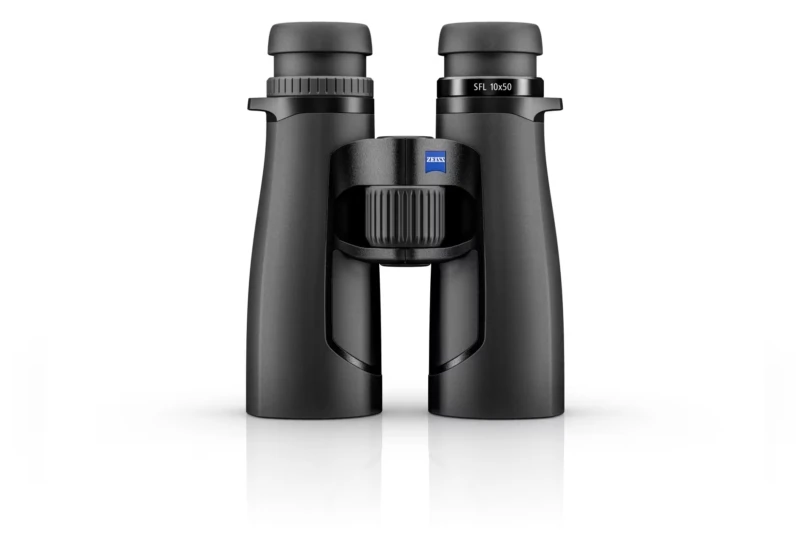
- Weight:
1 lb., 15 oz. - Close focus range:
5.9′ - Eye relief:
18 mm - Magnification:
10x - Objective lens:
50 mm - Field of view:
366′ - Prism:
Schmidt-Pechan (roof)
Pros
- Size and weight (fits in standard bino harnesses)
- Low light performance
- Excellent clarity
- Sensitive focus wheel
- Eyecups highly adjustable
- Price to quality
Cons
- Provided case
- Lens covers
- Price
Size of the ZEISS SFL 10×50 Binoculars
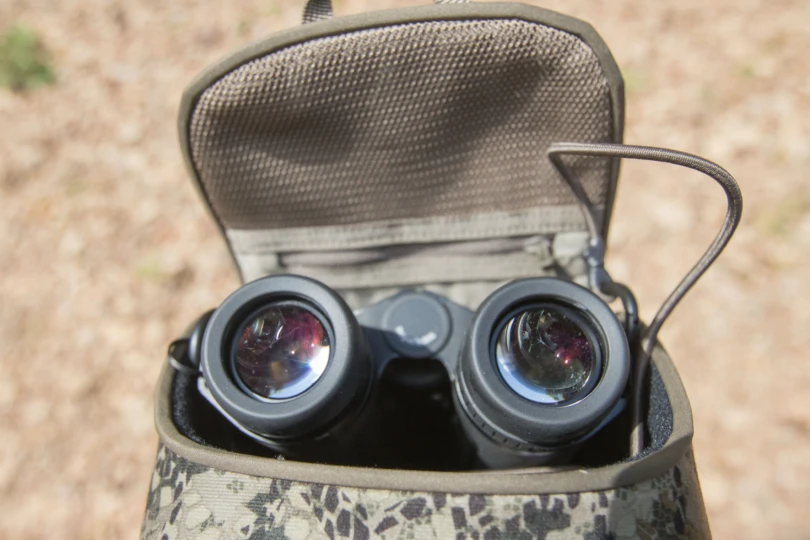
For hunters, the upside of running 50mm binoculars is obvious—better light gathering. And when you’re glassing at first or last light, that extra brightness can make all the difference. The problem has always been the trade-off: extra weight and bulk that most guys just don’t want to pack around.
That’s where the SFLs break the mold. ZEISS kept the 50mm glass but trimmed things down with a magnesium frame, slimmer lenses, and tighter spacing. The result? Some of the most compact 50mm binos I’ve ever handled. The real proof is that they slide right into a smaller harness like my Badlands Bino XR Pro without a fight.
Take a look at the comparison table below—you’ll see how the SFL stacks up against other 50mm models, and how shockingly close they are in size to the 42mm Swarovskis.
Binocular Size Comparison Chart
| Binocular | Weight | Length x Width |
|---|---|---|
| ZEISS SFL 10X50 | 30.8 oz. | 160 mm x 133 mm |
| Swarovski NL Pure 10X42 | 29.6 oz. | 158 mm x 131 mm |
| Swarovski NL Pure 10X52 | 36 oz. | 175 mm x 132 mm |
| Leupold BX-5 Santiam HD 10X50 | 31.5 oz. | 172 mm x 155 mm |
| Vortex Razor HD 10X50 | 28.1 oz. | 173 mm x 130 mm |
Compared to Swaro, the SFL is noticeably lighter. Against Vortex and Leupold, it’s not a huge difference—actually, it’s a bit heavier than the Razor—but the tubes are much shorter.
That 13mm difference might sound small, but it can make or break a bino harness fit. At 160mm long, the SFLs slide into all of mine, though a few are just barely deep enough. If they’d been even 5mm longer, I’d have needed a different harness.
What’s really impressive is that the SFL 10X50 delivers all the light-gathering power of a 50mm lens in a body the size of a 10X42. It feels great in the hand and makes long glassing sessions much more comfortable.
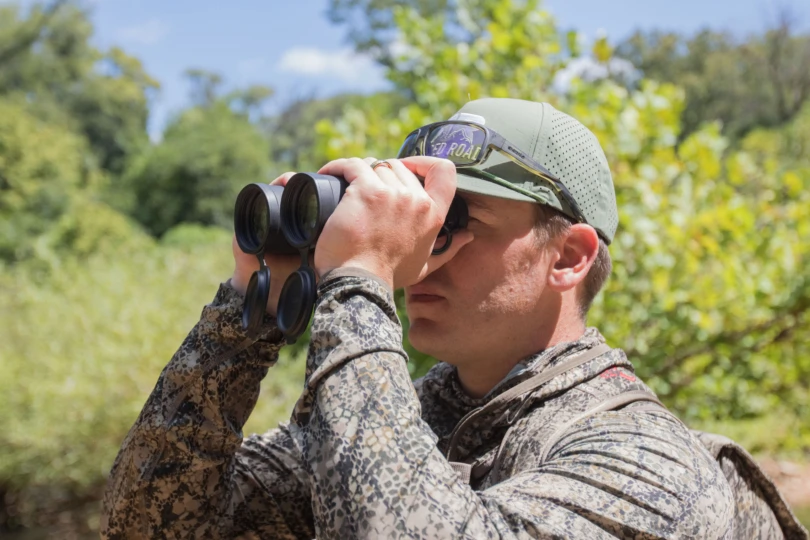



Low-Light Performance of the ZEISS SFL 10X50
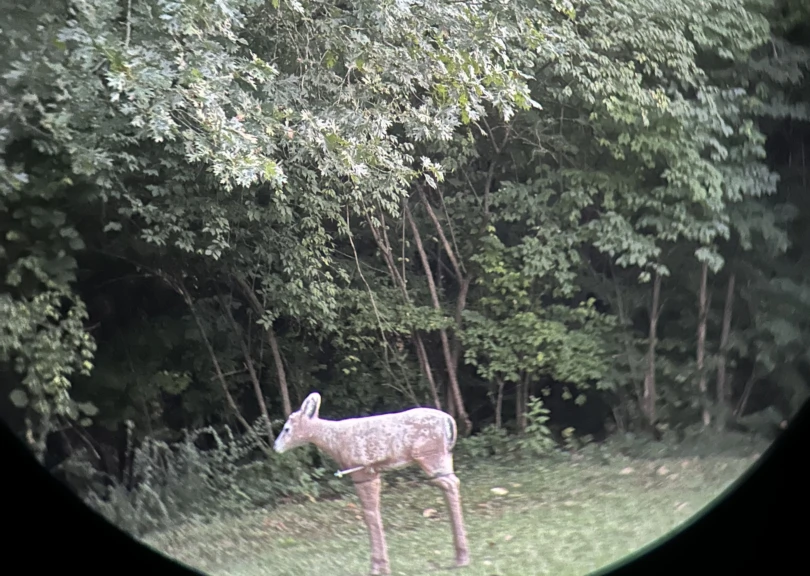



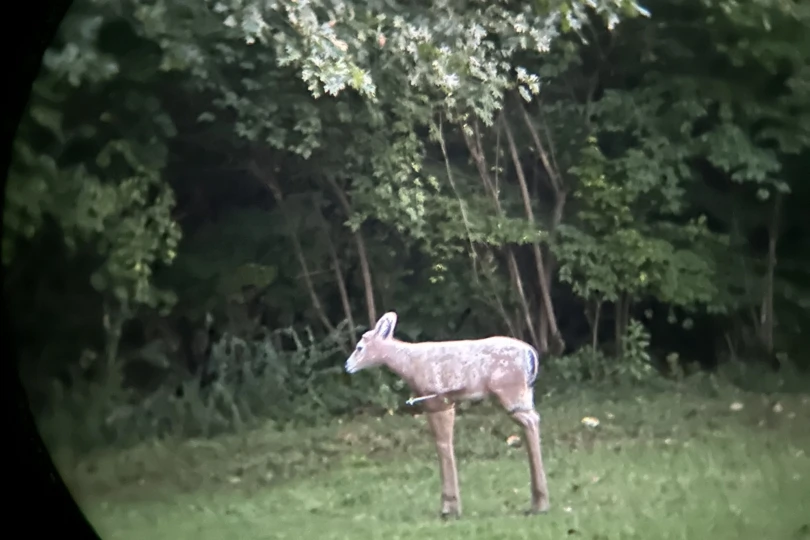



Write
One of the toughest challenges for hunters is glassing in thick cover during pre-dawn or post-sunset light. Colors fade, shadows blur, and what used to clearly be a patch of brown plants might suddenly look like a deer—or maybe just a stump. In low light, everything starts to blend together.
Using the 10X50 SFLs alongside several 10X42s, it quickly became obvious that the bigger objective lens makes a real difference. The image is brighter, and I can pick out objects faster. At last light, a questionable deer-shaped object half a mile away that was barely distinguishable in my 10X42s popped right into view with the SFLs.
These binos give me extra glassing time in extreme low-light conditions, which has earned them a permanent spot in my harness.
I also notice the benefits at my backyard 3D archery range. I aim to practice daily, but some days I only get a shot in during the last 10 minutes of light. Even when it’s nearly dark, I can still make out the cores on my targets—something my 10X42s just can’t do.
One note on the photos above: they were taken with an iPhone held up to the lens, so they don’t capture the true clarity of the 10X50 SFLs or even the Vortex 10X42s. In person, both are much sharper with minimal distortion. The images do, however, give a sense of the difference in light-gathering power—a difference that’s even more noticeable when it’s basically dark outside, beyond what a camera can capture.
Optical Clarity
At this price point, you expect top-tier optics—and the SFLs deliver. Edge-to-edge, the image is razor-sharp with virtually no distortion.
Whether it’s the tiny details on a drake wood duck’s head or counting the tines on a velvet buck, the 10X50s give a view that feels straight out of a Nat Geo shoot.
I haven’t noticed any significant chromatic aberration, no matter the light conditions. Even in situations with maximum glare—like bright sun bouncing off water while watching ducks—the SFLs handled it effortlessly. I even shifted my face around trying to induce glare, and still, nothing. They’re just a joy to glass with, in any light.
Honestly, when it comes to optical clarity, the ZEISS SFL 10X50s leave very little room for improvement. In real-world use, you’re getting about as perfect a view as it gets.
Eyecup Adjustability
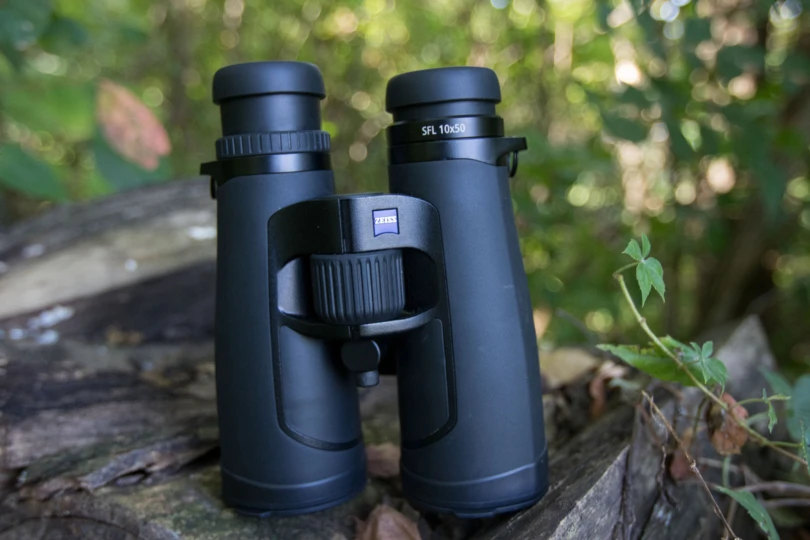



One feature that really stands out on the ZEISS SFLs is the eyecups. Most binoculars give you just two positions: fully in for eyeglass wearers or fully out for everyone else. The SFLs add two more positions in between, letting you dial in the perfect fit for your face. For me, the second-from-fully-extended setting hits the sweet spot. I wish more brands offered this level of adjustability.
And when it comes time to clean the lenses, you can keep twisting the eyecups all the way off, giving full access to the optics. Simple, but smart.
Focus Wheel of the ZEISS SFL 10X50
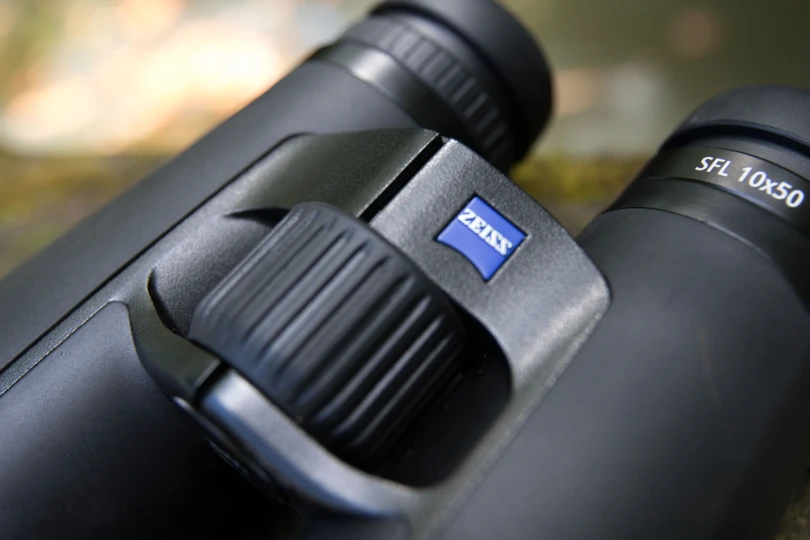



The first time I put the SFLs to my eyes, I went to adjust the focus and… wow. The focus wheel is super sensitive—real touchy.
From its close focus at 5.9 feet all the way to infinity, the wheel only takes 1.4 turns. That means tiny movements of your fingertip adjust the focus dramatically. At first, it felt a little off-putting.
But within ten minutes, I got used to it. After a few days, I was hooked. Being able to dial in perfect focus with the slightest touch is a game-changer. Now, when I pick up my other binoculars, it feels like I’m wasting time trying to get a sharp image. The SFL lets you fine-tune every detail to absolute perfection.
Other Fun Specs, Compared
When you stack the ZEISS SFL against other popular 10×50 binoculars, it really stands out. One of the biggest advantages is the field of view.
At 1,000 yards, the SFL gives you 366 feet of view. By comparison, the similarly priced Vortex Razor HD clocks in at 315 feet, and the more budget-friendly Leupold BX-5 Santiam HD comes in at 304 feet. Simply put, with the SFL you can see more ground without moving the glass.
The only binocular in this group that beats the SFL is the Swarovski NL Pure, which has a massive 390-foot field of view—but those run nearly $2,000 more. For hunters looking for a wide view without breaking the bank, the SFL hits a sweet spot.
Close-Distance Focus
While hunters might not care much about it, anyone who enjoys spotting butterflies, flowers, or occasionally birds up close should pay attention to close focus distance—the nearest point where the image stays sharp.
On this front, the ZEISS SFL is a clear winner:
- ZEISS SFL: 5.9 feet
- Swarovski NL Pure: 10.8 feet
- Vortex Razor HD: 10 feet
- Leupold BX-5 Santiam HD: 11.4 feet
That means with the SFL, you can get almost twice as close to your subject and still enjoy a crisp, clear view—a huge bonus for nature watchers and detail lovers.
Warranty
The ZEISS SFL warranty is fairly standard, though, like most, it’s wrapped in a lot of legal language. Essentially, the binoculars are covered against defects and workmanship for the life of the product—whatever that means in practice. There’s some room for interpretation on ZEISS’s end. You can read the full details on their site.
It’s worth noting that the SFLs don’t qualify for ZEISS’s 5-year accidental coverage policy. So while the warranty isn’t the strongest out there, it’s far from the worst. For a deeper dive on how it stacks up, check out Hunt/Fish Editor Rachelle Schrute’s guide to binocular warranties.
Where the ZEISS SFL 10×50 Misses
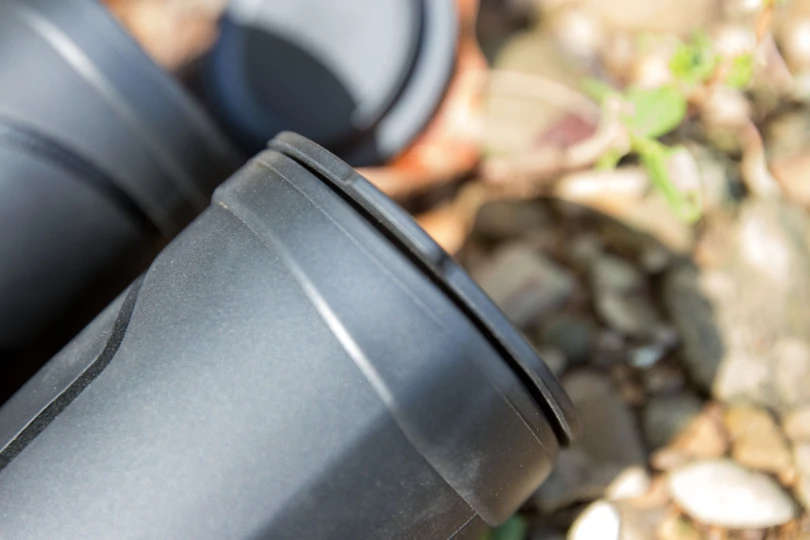



It’s rare for me to test a product and not find anything to complain about—but when it comes to the SFL binoculars themselves, I’ve got nothing.
Sure, I initially wasn’t a fan of the touchy focus wheel, but I quickly fell in love with it. That’s not me sugarcoating anything for ZEISS—the binos are genuinely excellent.
The only real drawbacks are with the included accessories, which honestly aren’t a huge deal. The case is a simple, soft-shell square with no straps, not a full binocular harness. I don’t care, since I use aftermarket harnesses anyway. If you’re spending $1,800 on optics, chances are you do too, so no real loss there.
The lens covers, however, are a bit frustrating. They’re tricky to seat properly—the inner ring often doesn’t line up, so only half the ring sits correctly, and they tend to fall off when you tilt the binos.
When I put the SFLs in my harness, the covers would slip, crumple at the bottom, and make the binoculars sit way too high. The harness couldn’t even close properly. I gave it a few weeks, hoping they’d “break in,” but no luck. In the end, I just ditched the covers altogether. It’s a minor nuisance, but something to be aware of.
The Verdict
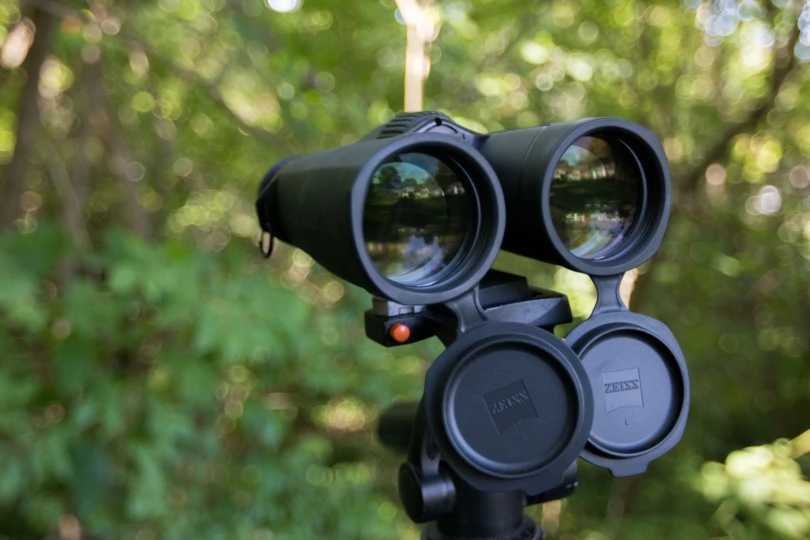



Write
If you’re willing to spend some serious cash on binoculars and want a 50mm objective lens, I honestly don’t see why you’d look anywhere else. ZEISS really knocked this one out of the park.
The SFL 10×50 is more compact than most other 50mm options, with optical performance that can easily compete with any high-end bino out there. On top of that, the specs hold up extremely well compared to the competition.
And the price? For German optics, $1,800 is a steal compared to something like Swarovski, which is made just next door in Austria. For the performance and compact design you get, it’s absolutely worth the investment in my eyes.
Even if you weren’t originally considering a 50mm pair, these might make you rethink that choice. They’ve claimed the top spot in my hunting bino harness thanks to the extra low-light performance without any heavy weight penalties. They’re staying there until something genuinely better comes along.
FAQ’s
1. Where are Zeiss SFL binoculars made?
Zeiss SFL binoculars are designed in Germany but manufactured in Japan. This combination ensures top-notch design and reliable craftsmanship, giving you high-quality optics with lightweight, portable features.
2. Which Zeiss binoculars are the best?
It depends on what you’re looking for! Some of the top Zeiss models include:
Victory SF – Great field of view and lightweight, perfect for birdwatching and long-distance spotting.
Conquest HD – High-definition optics at a more affordable price, versatile for many outdoor activities.
SFL – Lightweight and portable, but still delivers excellent optical performance.
The “best” really comes down to your needs—magnification, weight, and where you’ll use them.
3. Are Zeiss binoculars worth it?
Yes! Zeiss binoculars are considered a solid investment because of their sharp optics, durability, and comfort. They are pricier than some brands, but the clarity, long-lasting quality, and smooth performance make them worth it for serious outdoor enthusiasts.
4. Can you see the moon with 10×50 binoculars?
Absolutely! A 10×50 pair is excellent for moon-gazing. The 10x magnification brings lunar craters and surface details into clear view, while the 50mm lenses gather plenty of light to give bright, crisp images.
